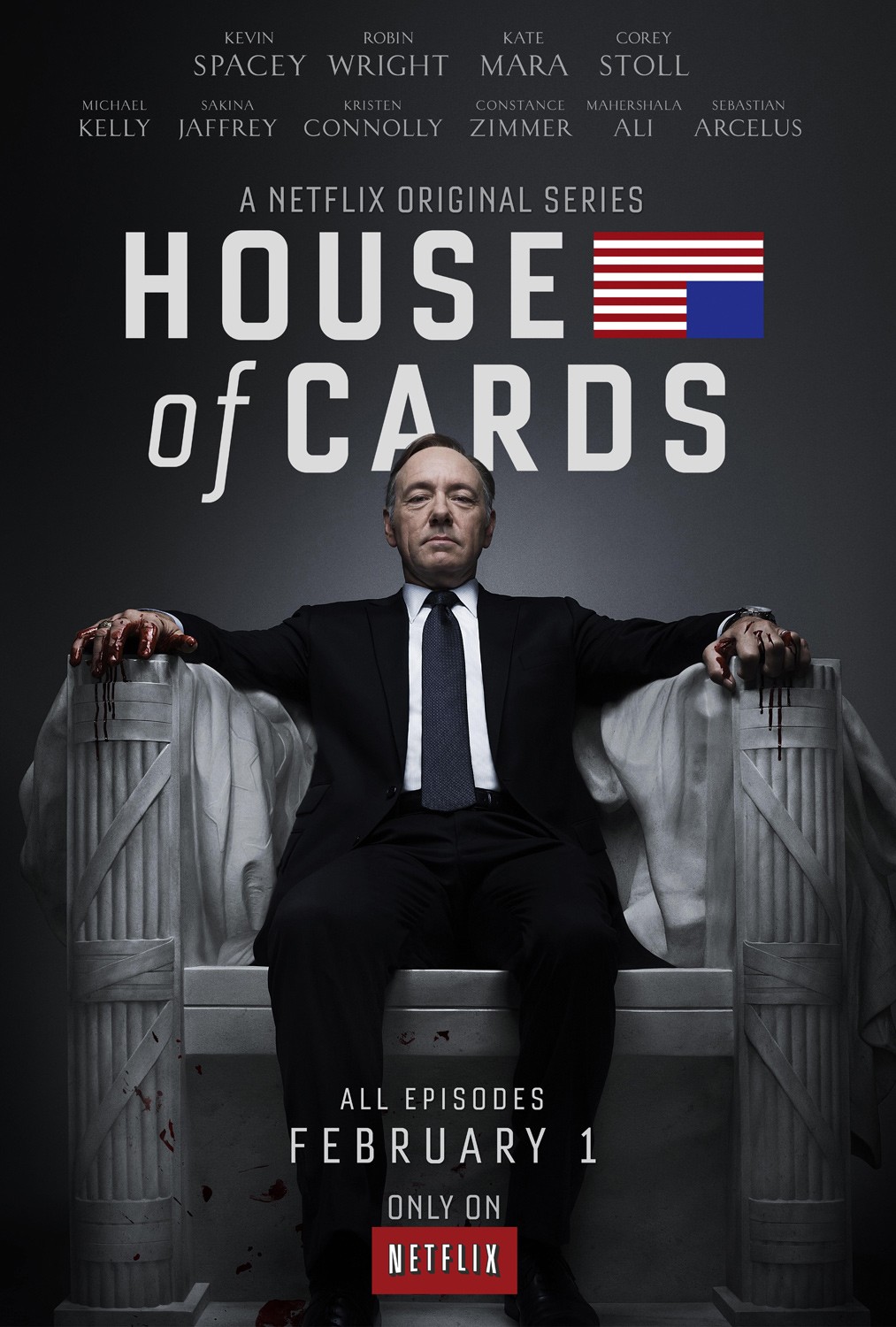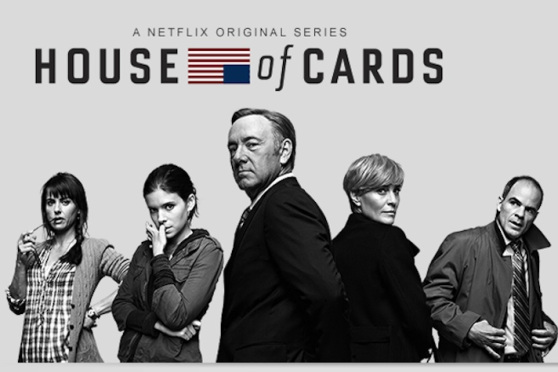justin matchick looks at the Netflix original series…
Is Netflix’s new original series House of Cards the future of the way we watch television?
Television critics have been trying to answer this question ever since the entire first season was released on a single day a month ago. No need to wait an entire week to see how the story and characters will develop, everything is there from the get-go allowing you to watch everything in one huge marathon. This method of distribution will carry over to other Netflix original programming, so when Arrested Development returns this May it too will all be available on the same day. People already have used sites like Netflix to marathon many episodes of TV shows in one sitting, but for a show to debut with its entire first season available for viewing is unprecedented.
Does a person like a show more if they view the episodes back to back as one long narrative, or does it serve the viewer better if there are long breaks between episodes to allow for analysis and thought over the events of an episode? With this in mind, I decided against viewing all 13 episodes in one day. Instead, I watched the first episode one night, seven episodes the next day, three the day after that, and final two on the next day. This way, I was able to properly digest the first and final few episodes on their own while also experiencing marathoning several episodes in one go. What I found was a show rewarding not only in its storylines and characters, but in the way it is watched and processed.
House of Cards follows Kevin Spacey as South Carolina Representative Francis Underwood. As the series begins we learn that Underwood has been instrumental in getting the recently elected President Walker (Michael Gill) into office. Underwood expects Walker to give him the nomination for Secretary of State as a token of appreciation, but soon Walker’s Chief of Staff Linda Vasquez (Sakina Jaffrey) lets him know he has been passed over for the nomination. Angered that the President has gone back on his promise of nominating him, Underwood decides to begin a reign of sabotage and subterfuge to gain a stronger foothold in the White House and eventually usurp power from the President. Underwood is a commanding, intimidating force of nature. As courteous as he is cunning, his southern drawl is infectious, sinister, and charming all at once. He is not a hero, anti-hero, or a villain. Sometimes you are rooting for him while at other points you’d love to see him fail. He is the antagonizing protagonist, someone who is always one step ahead of his enemies and two steps ahead of the audience.
http://youtu.be/ULwUzF1q5w4
There are three other major characters and plotlines the show follows that intersect with the main plot of Underwood’s plan in various ways. Underwood’s wife Claire (Robin Wright) runs a non-profit focusing on bringing clean water to third world countries. Young reporter Zoe Barnes (Kate Mara) is hungry for a big break and will even ignore journalistic ethics to get closer to Underwood. Meanwhile, there is up-and-coming Congressman Peter Russo (Corey Stoll) from South Philadelphia, a drug addicted and alcoholic young man who eventually becomes Underwood’s lackey after a hushed-up drunk driving arrest. Barnes and Russo come close to being the heroes of the show in place of Underwood, but Russo’s demons come up too often for us to truly get behind him. Zoe, while being the most virtuous character on the show, gets too wrapped up in protecting herself that it’s difficult for the viewer to form a connection with such a selfish character.
As these four main plots intertwine and cross over with one another House of Cards blurs the line between episodic television show and massively long film. If you were to take out the intro and outro credits of each episode the entire season could be stitched together into one 12 hour film. The series is filmed with a cinematic flair, using a stark sense of minimalism both in its sets and in its use of shadows and colors. This is of course helped by the fact that the series was executive produced by director David Fincher. Although he only directs the first two episodes of the show, the entire series has his trademark uses of low-key lighting, harsh shadows, and intense close-ups. The movielike style of the show is aided by a beautiful score from composer Jeff Beal. Using a dark musical style which helps highlight both the political thrills and powerful drama of the show, I really do hope they release an official soundtrack for Beal’s score soon.
The performances in House of Cards are unmatched by other television shows. Spacey and Stoll are almost guaranteed to get Emmy nominations for their performances, and are early frontrunners to win (yes, even though the show has not aired on a television network the show will still be eligible for Emmy nominations). A supporting cast that includes character actors like Michael Kelly, Mahershala Ali, Kristen Connolly and Sandrine Holt are equally as fantastic when on screen, delivering performance after captivating performance. Many are aided by a superb script from The Ides of March writer Beau Williamson. While the show seems to try too hard at times to match the fast pace and wittiness of Aaron Sorkin’s writing for The West Wing, it still provides many memorable and easily quotable lines.
The show only really begins to stutter and slow down when we stray too far from Underwood’s plot for revenge. While the subplots about Congressman Russo and intrepid reporter Zoe are very closely tied to Underwood’s story, focusing on his wife Claire’s organization takes us too far away from all the action. While there are a few scenes where Claire’s non-profit is used as a bargaining chip for Underwood, the show loses a lot of steam when we are treated to sequences of Claire meeting up with an old flame that might drive a stake between her and Francis. These scenes take up too much time in the middle of the season both distracting from the main plot and just being incredibly boring in general. This story could have been handled much better, been much more compact, and used more efficiently instead of being just a diversion from the good stuff. Luckily, this is only a minor complaint and by the last two or three episodes you will all but forget that such a dismal plotline even interfered with your viewing of the show.
There are no episode titles in House of Cards. Every episode is referred to as a chapter, signifying that this is a work meant to be viewed not simply episode by episode but as one large piece. Without a week to digest the events of a chapter like with most shows on television, everything starts to blend together just becoming one massive narrative. I couldn’t tell you what exactly happened in the fourth episode or the seventh episode. The larger plotlines, dealing with teacher’s union strikes, gubernatorial races, and getting important bills passed all develop over several episodes and unfold to reveal how they fit into Underwood’s larger plan. Anyone with a Netflix account owes it to themselves to watch House of Cards, whether you watch it once a week as you would a regular TV show or all at once in one marathon viewing session, the same sense of enjoyment can be found. Coming to us right at a time when Mad Men, Breaking Bad, Game of Thrones, and Boardwalk Empire are all out of season, House of Cards is must see television (or rather must see Netflix).
Watch House of Cards on Netflix by clicking this link.
You can also get a Netflix coupon here courtesy of Raw Feed.com






Comments are closed.